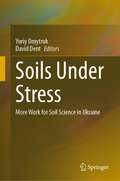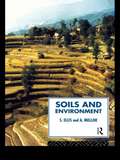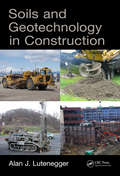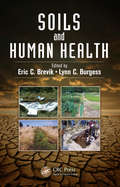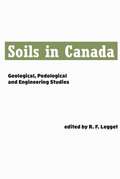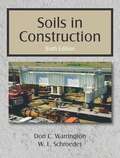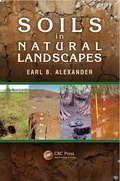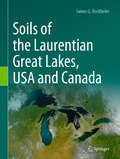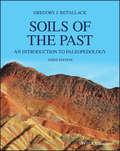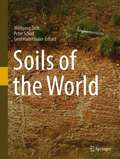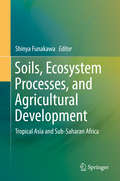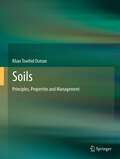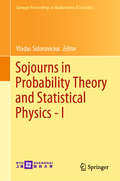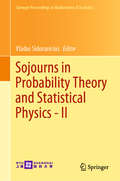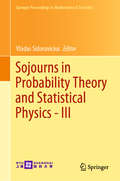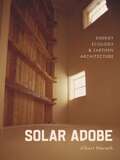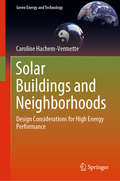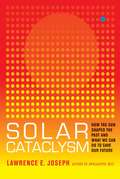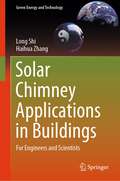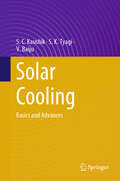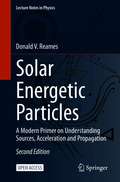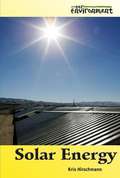- Table View
- List View
Soils Under Stress: More Work for Soil Science in Ukraine
by David Dent Yuriy DmytrukDokuchaev carried out most of his research in Ukraine. His student and friend, Volodymyr Vernadsky, went on to create trans-disciplinary environmental sciences and the concept of Earth as a living organism, famously taken up by James Lovelock. That spring of ideas still flows and the researches captured in this volume are relevant to present-day problems, and not only in Ukraine.Soils have always been under stress but, in the Anthropocene, mankind is in the driving seat. As a sequel to Soil Science Working for a Living: Applications of soil science to present-day problems, we consider issues of policy as well as soil genesis, attributes and functions in various environments, natural and man-made. We consider human impacts on the soil cover through its use and misuse, highlight methods of research and assessment of soil quality, and the threats of soil degradation. The distinguished contributors also describe and propose various options for evaluation and remediation of degraded soils, drawing on the latest methods of modelling and cartography as well as long-term field experiments and long experience.The book will be invaluable to researchers and practitioners in soil science including graduate and post-graduate education, academics and professionals.
Soils and Environment
by Steve Ellis Tony MellorSoils represent the result of a complex set of interacting processes and are an integral component of the environment. Yet soils remain the most undervalued and misused of the Earth's resources. This work examines the fundamental importance of soils. Combining practical analysis and interpretation with a theoretical approach, the authors discuss the properties of soils, debate the environmental factors that influence their development, and address their resulting spatial characteristics on a global scale. Examining the impact of environmental controls on soil formation this book also analyzes the role of soils as components of natural environmental systems, and soil-human interactions. A glossary of terms aids the less scientific reader. Adopting macro and micro-scale, pure and applied, spatial and temporal, and natural and human related approaches, this book offers an understanding of soils within an environmental context. As environmental problems, such as pollution, acidification, erosion and climatic change become matters of greater concern, this work offers an understanding for readers across a spectrum of environmentally-related subjects.
Soils and Geotechnology in Construction
by Alan J. LuteneggerThis book covers the field of applied geotechnology related to all aspects of construction in ground, including compacted fill, excavations, ground improvement, foundations, earth retaining systems and geotechnical site characterization. It suits the first year of a graduate course on ground improvement and geoconstruction and will suit practicing engineers, both consultants and contractors. Distinctively it covers the identification of problematic soils and appropriate mitigation measures, and the inspection of ground construction work. It combines the technical and the practical in applied geotechnology.
Soils and Human Health
by Eric C. Brevik Lynn C. BurgessDespite the connections between soils and human health, there has not been a great amount of attention focused on this area when compared to many other fields of scientific and medical study. Soils and Human Health brings together authors from diverse fields with an interest in soils and human health, including soil science, geology, geography, bio
Soils in Canada: Geological, Pedological and Engineering Studies (The Royal Society of Canada Special Publications #3)
by Robert LeggetThis work originated in a Symposium forming part of the programme for Section IV (Geological Sciences including Mineralogy) of the Royal Society of Canada, which met at Queen's University, Kingston, in 1960. Of wide scope, it demonstrates the progress now being made in Canada in the study of its vast area of soils. The papers of this Symposium are unique in that they present for the first time a combined picture of three aspects of soil science–the geological, the pedological (or agricultural), and the engineering (known as Soil Mechanics). The book serves, of course, mainly as an introduction to a large subject, but some more detailed papers give an idea of the depth as well as the wide range of soil studies in Canada today. The contents can be summarized as follows. First come seven papers on Pleistocene geology in Canada, followed by a study of muskeg (which forms half a million square miles of Canada's surface) and one of soil mineralogy. Four papers–one general and three regional–of pedological interest follow. Finally come four papers on soil mechanics: one relating agricultural and engineering soil studies; one discussing geology's influence on the siting and building of airports; a detailed account of the properties of Leda clay; and a general review of the soil problems facing the Canadian civil engineer.
Soils in Construction
by Don C. Warrington W. L. SchroederMost geotechnical books on soil mechanics or foundations focus exclusively on the needs of engineers. But the increasing complexity of the construction environment requires construction and engineering managers to know more about engineering requirements. Soils in Construction provides students in those disciplines with the necessary background to make informed decisions about soils. Every chapter of the Sixth Edition has been thoroughly updated, with all examples made even more clear and easier for students to follow. Many photos illustrate the concepts and applications of soils and geotechnical structures throughout the book. An appendix detailing lab procedures allow the book to serve those courses with a lab component while still maintaining flexibility for those without.
Soils in Natural Landscapes
by Earl B. AlexanderIn any complete investigation of terrestrial ecosystems, rocks and soils must be considered. Soils are essential resources, providing water and nutrients for vascular plants, and mitigating the flow of water from the land. In addition, soil diversity is critical for biotic diversity. While there are many references on the agricultural perspective o
Soils of South Africa
by Martin FeySoils of South Africa is the first book in seventy years that provides a comprehensive account of South African soils. The book arranges more than seventy soil forms into fourteen groups and then provides, for each group: • maps showing their distribution and abundance throughout South Africa • descriptions of morphological, chemical and physical properties • a detailed account of classification and its correlation with international systems • a discussion of soil genesis which includes a review of relevant research papers • appraisal of soil quality from a land use perspective as well as for its ecological significance • illustrative examples of soil profiles with analytical data and accompanying interpretations. There is also a fascinating account of the special relationship that exists between South African animals and soil environments. Soils of South Africa should interest students and researchers in the earth, environmental and biological sciences, as well as environmental practitioners, farmers, foresters and civil engineers.
Soils of the Laurentian Great Lakes, USA and Canada
by James G. BockheimThis book introduces the reader to the Great Lakes and considers their soil-forming factors and processes, taxonomic structure of the soils, soil geography and pedodiversity, while also addressing the importance and protection of soils in the Great Lakes Coastal Zone. The Great Lakes are an important part of the USA and Canada. Home to 33 million people, including 90% of all Canadians, the Great Lakes account for 20% of the world’s surface freshwater and 90% of the USA’s freshwater. Key industries include shipping, steel and automobile production, energy generation, fishing, pulp and papermaking, agriculture, and recreation. To date, there has been no comprehensive inventory of the region’s soils, which are now subject to dramatic climate change and environmental degradation. This book was prepared using the US Department of Agriculture, Natural Resources Conservation Service databases, including the Web Soil Survey, Soil Series Extent Explorer, soil classification and characterization databases, and county soil surveys, supplemented by shoreline viewer software, the author’s independent research, consultation with colleagues, and survey trips around the Great Lakes.
Soils of the Past: An Introduction to Paleopedology
by Gregory J. RetallackA student-friendly textbook that describes ancient soils, how they may be identified, and their use in paleoenvironmental reconstruction Ancient soils contain vital mineralogical, geochemical, textural, and paleontological information about the continental environments in which they formed. Advances in isotope geochemistry and sequence-stratigraphic models allow evermore detailed reconstructions of environmental change from paleosols, and new insights into such diverse topics as atmospheric chemistry, global change, paleoecology, geobiology and mass extinction. This book educates readers about the field of paleopedology and how it remains a key area of investigation for geologists and environmental scientists seeking to learn about, and reconstruct, the condition and evolution of paleoenvironments. Presented in three sections—Soils and Palesols; Factors in Soil Formation; and Fossil Record of Soils—Soils of the Past: An Introduction to Paleopedology describes the main types of ancient soil, procedures for identifying and studying them, their classification and, most significantly, a wide array of examples of how paleosols have been used for paleoenvironmental reconstruction. The book is an excellent reflection of the current state of knowledge and can be widely adopted over many disciplines. All chapters have been revised and updated to reflect advances in soil science in the last two decades New tables display a wealth of new data added since the 2nd edition published in 2001 New figures have been added and line art has been redrawn to improve clarity and promote understanding References have been updated throughout Soils of the Past, 3rd Edition is written for advanced undergraduates studying paleopedology as part of a degree in geology, environmental science, or physical geography, and for interested professional earth scientists.
Soils of the World
by Wolfgang Zech Peter Schad Gerd Hintermaier-ErhardThis book describes and comprehensively illustrates the soils of the world in accordance with the worldwide WRB classification. The structure of the book follows the ecozone concept. For every ecozone, location, climate and vegetation as well as soil formation and distribution are presented. All soils representative of the corresponding ecozone are then described in detail: definition, properties, distribution, use, classification, genesis. Over 260 photographs illustrate soil profiles, soil details and landscapes. Instructive maps and graphs help understand soil properties and soil-forming processes and make the publication an excellent reference book about the world's soils.
Soils, Ecosystem Processes, and Agricultural Development
by Shinya FunakawaThe main objective of this book is to integrate environmental knowledge observed in local agriculture, based on the understanding of soils science and ecology, and to propose possible technical solutions and a more integrated approach to tropical agriculture. The chapters describe and analyze the ecological and technical countermeasures available for mitigating environmental degradation due to the increasing agricultural activities by humans, based on our scientific understanding of traditional agriculture in the tropics. This is an effective approach, as such ecological and technical tools previously involved in traditional activities are expected to be easily incorporated into present agricultural systems. The book starts with a rather classical pedological issue and analyzed traditional agricultural practices with different resource management strategies in terms of their modification of natural biological processes. It focuses on the present situation of tropical agriculture; that is, resource utilization in modern agriculture after application of technical innovation (increased application of chemical fertilizers as well as agricultural chemicals). Here, possible technical approaches to resource management that reasonably support agricultural production whilst mitigating environmental degradation are discussed. The negative impacts of agricultural development on our environment are rapidly growing, yet we are increasingly dependent on the agricultural sector for food and energy. The situation is similar in the tropics, where subsistence agriculture with low input management has long comprised most agricultural systems. Comparison of ecological and/or agronomical studies between different continents are still rare; therefore, this analysis may help clarify what is an essential problem when considering technical transportation beyond continents and/or between temperate and tropical regions.
Soils, Plants and Clay Minerals
by Pierre Barré Pierre VeldeThis book considers the inter-relations between plants and minerals in an entirely new way, in that it introduces the notion of eco-engineering: i.e. the manipulation of the mineral world by the living world to the ends of the living world. These inter-relations are the basis for traditional agriculture and should be the basis for new, ecologically oriented land management disciplines, including agriculture itself. These relations also have an impact on surface geochemistry and determine pollution problems. A better understanding of this concept will lead to a renewed consideration of surface environmental problems.
Soils: Genesis and Geomorphology
by Randall J Schaetzl Sharon AndersonSoils: Genesis and Geomorphology is a comprehensive and accessible textbook on all aspects of soils. The book's introductory chapters on soil morphology, physics, mineralogy and organisms prepare the reader for the more advanced and thorough treatment that follows. Theory and processes of soil genesis and geomorphology form the backbone of the book, rather than the emphasis on soil classification that permeates other less imaginative soils textbooks. This refreshingly readable text takes a truly global perspective, with many examples from around the world sprinkled throughout. Replete with hundreds of high quality figures and a large glossary, this book will be invaluable for anyone studying soils, landforms and landscape change. Soils: Genesis and Geomorphology is an ideal textbook for mid- to upper-level undergraduate and graduate level courses in soils, pedology and geomorphology. It will also be an invaluable reference text for researchers.
Soils: Principles, Properties and Management
by Khan Towhid OsmanAimed at taking the mystery out of soil science, Soils: Principles, Properties and Management is a text for undergraduate/graduate students who study soil as a natural resource. Written in a reader-friendly style, with a host of examples, figures and tables, the book leads the reader from the basics of soil science through to complex situations, covering such topics as: the origin, development and classification of soil physical, chemical and biological properties of soil water and nutrient management management of problem soils, wetland soils and forest soils soil degradation Further, the ecological and agrological functions of soil are emphasized in the context of food security, biodiversity and climate change. The interactions between the environment and soil management are highlighted. Soil is viewed as an ecosystem itself and as a part of larger terrestrial ecosystems.
Sojourns in Probability Theory and Statistical Physics - I: Spin Glasses and Statistical Mechanics, A Festschrift for Charles M. Newman (Springer Proceedings in Mathematics & Statistics #298)
by Vladas SidoraviciusCharles M. (Chuck) Newman has been a leader in Probability Theory and Statistical Physics for nearly half a century. This three-volume set is a celebration of the far-reaching scientific impact of his work. It consists of articles by Chuck’s collaborators and colleagues across a number of the fields to which he has made contributions of fundamental significance. This publication was conceived during a conference in 2016 at NYU Shanghai that coincided with Chuck's 70th birthday.The sub-titles of the three volumes are: I. Spin Glasses and Statistical MechanicsII. Brownian Web and PercolationIII. Interacting Particle Systems and Random Walks The articles in these volumes, which cover a wide spectrum of topics, will be especially useful for graduate students and researchers who seek initiation and inspiration in Probability Theory and Statistical Physics.
Sojourns in Probability Theory and Statistical Physics - II: Brownian Web and Percolation, A Festschrift for Charles M. Newman (Springer Proceedings in Mathematics & Statistics #299)
by Vladas SidoraviciusCharles M. (Chuck) Newman has been a leader in Probability Theory and Statistical Physics for nearly half a century. This three-volume set is a celebration of the far-reaching scientific impact of his work. It consists of articles by Chuck’s collaborators and colleagues across a number of the fields to which he has made contributions of fundamental significance. This publication was conceived during a conference in 2016 at NYU Shanghai that coincided with Chuck's 70th birthday.The sub-titles of the three volumes are:I. Spin Glasses and Statistical MechanicsII. Brownian Web and PercolationIII. Interacting Particle Systems and Random WalksThe articles in these volumes, which cover a wide spectrum of topics, will be especially useful for graduate students and researchers who seek initiation and inspiration in Probability Theory and Statistical Physics.
Sojourns in Probability Theory and Statistical Physics - III: Interacting Particle Systems and Random Walks, A Festschrift for Charles M. Newman (Springer Proceedings in Mathematics & Statistics #300)
by Vladas SidoraviciusCharles M. (Chuck) Newman has been a leader in Probability Theory and Statistical Physics for nearly half a century. This three-volume set is a celebration of the far-reaching scientific impact of his work. It consists of articles by Chuck’s collaborators and colleagues across a number of the fields to which he has made contributions of fundamental significance. This publication was conceived during a conference in 2016 at NYU Shanghai that coincided with Chuck's 70th birthday.The sub-titles of the three volumes are:I. Spin Glasses and Statistical MechanicsII. Brownian Web and PercolationIII. Interacting Particle Systems and Random WalksThe articles in these volumes, which cover a wide spectrum of topics, will be especially useful for graduate students and researchers who seek initiation and inspiration in Probability Theory and Statistical Physics.
Solar Adobe: Energy, Ecology, and Earthen Architecture
by Albert NarathHow a centuries-old architectural tradition reemerged as a potential solution to the political and environmental crises of the 1970s Against the backdrop of a global energy crisis, a widespread movement embracing the use of raw earth materials for building construction emerged in the 1970s. Solar Adobe examines this new wave of architectural experimentation taking place in the United States, detailing how an ancient tradition became a point of convergence for issues of environmentalism, architecture, technology, and Indigenous resistance. Utilized for centuries by the Pueblo people of the American Southwest and by Spanish colonialists, adobe construction found renewed interest as various groups contended with the troubled legacies of modern architecture and an increasingly urgent need for sustainable design practices. In this period of critical experimentation, design networks that included architects, historians, counterculture communities, government weapons labs, and Indigenous activists all looked to adobe as a means to address pressing environmental and political issues. Albert Narath charts the unique capacities of adobe construction across a wide range of contexts, consistently troubling simple distinctions between traditional and modern technologies, high design and vernacular architecture. Drawing insightful parallels between architecture, environmentalism, and movements for Indigenous sovereignty, Solar Adobe stresses the importance of considering the history of the built environment in conjunction with architecture&’s larger impact on the natural world.
Solar Buildings and Neighborhoods: Design Considerations for High Energy Performance (Green Energy and Technology)
by Caroline Hachem-VermetteThis book presents the main principles for designing buildings and neighborhoods with increased potential to capture and utilize solar energy. It discusses practical issues in the design of the built environment and their impact on energy performance; and a range of design considerations, from building components (e.g. the building envelope) to urban planning issues (e.g. density and street layouts). In addition to design guidelines on how to increase buildings’ potential to capture solar energy, the book provides creative tips to increase the aesthetic value of solar technology integration in buildings. Helping readers plan energy-efficient buildings with innovative building envelope technologies, and to understand the impact of early-stage design considerations on the energy performance of buildings and communities, the book offers a valuable source of information for building professionals, including architects, engineers, and urban planners. It can also serve as a reference guide for academics and students of energy efficiency in buildings and urban planning.
Solar Cataclysm: How the Sun Shaped the Past and What We Can Do to Save Our Future
by Lawrence E. JosephScience journalist and futurist Lawrence Joseph has studied the unprecedented solar storms since the last ice age and in Solar Cataclysm he reveals the monumental ecological, biological, emotional, political, financial, and cultural effects they have had in the past, and will ultimately have on humanity’s future. This timely, fascinating, and relevant book from the bestselling author of Apocalypse 2012 sounds an intelligent and urgent warning about the possible catastrophic consequences we will face in the coming years if we don’t listen to what the sun is trying to tell us. Popular science fans who made The World Without Us a runaway bestseller, readers open to new angles on history like those presented in Guns, Germs, and Steel, and anyone who is concerned about tomorrow and what we can do to ensure humankind’s survival must read Solar Cataclysm.
Solar Chimney Applications in Buildings: For Engineers and Scientists (Green Energy and Technology)
by Long Shi Haihua ZhangThis book comprehensively describes the operating principles and theoretical foundations of solar chimneys. It covers current research results, including numerical analysis and mathematical models based on different assumptions. Complying with the application of renewable energy in sustainable buildings, solar chimney has received extensive attention as an indispensable part natural ventilation. This book is a guide to the application of solar chimneys from single zones to multi zones, and it provides a reference source of application for construction practitioners and engineering decision-makers. The design basis and the related basic principles of fluid mechanics and natural ventilation design strategies introduced in this book will also be beneficial to college students.
Solar Cooling: Basics and Advances
by S. C. Kaushik S. K. Tyagi V. BaijuThe book deals with the research activities focussed on solar VAD systems evaluating its merit of compatibility with ozone friendly refrigerants and adoptability with solar energy option. The authors of this book have given more emphasis on discussing various solar cooling VAD systems and its viability for the commercial use. Relevant references on "Solar Cooling: Basics and Advances" has been provided which significantly adopt some of the information for the completeness of the book.
Solar Energetic Particles: A Modern Primer on Understanding Sources, Acceleration and Propagation (Lecture Notes in Physics #978)
by Donald V. ReamesThis open access book serves as a concise primer introducing the non-specialist reader to the physics of solar energetic particles (SEP). It systematically reviews the evidence for the two main mechanisms which lead to the so-called impulsive and gradual SEP events. This second edition contains two completely new chapters discussing element abundances and shock waves, reflecting new theoretical, modeling, and observational results. Existing chapters have been substantially expanded or updated with additions placed in a broader context.More specifically, the author discusses the timing of the onsets of SEPs, their longitude distributions, their high-energy spectral shapes, their correlations with other solar phenomena, as well as the all-important elemental and isotopic abundances. The book relates impulsive SEP events to magnetic reconnection in solar flares and jets. The concept of shock acceleration by scattering on self-amplified Alfvén waves is introduced, as is the evidence of reacceleration of impulsive-SEP material in the seed population accessed by the shocks in gradual events. The text then develops processes of transport of ions out to an observer. Finally, a technique to determine the source plasma temperature in both impulsive and gradual events is demonstrated.The author also mentions the role of SEP events as a radiation hazard in space and briefly discusses the nature of the main particle telescope designs that have contributed to most of the SEP measurements.
Solar Energy (Our Environment)
by Kris HirschmannHumankind's dependence on fossil fuels is depleting the Earth's resources. Solar energy is one possible solution to this problem. This book examines all aspects of the solar energy question-how solar energy works, its problems and potential, where it is being used today and more.
